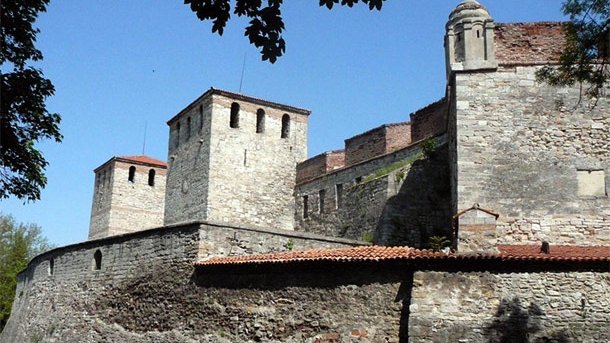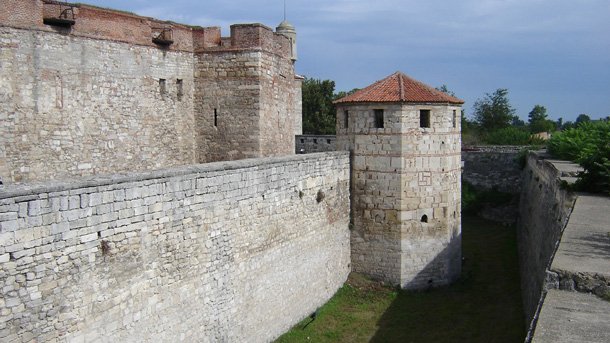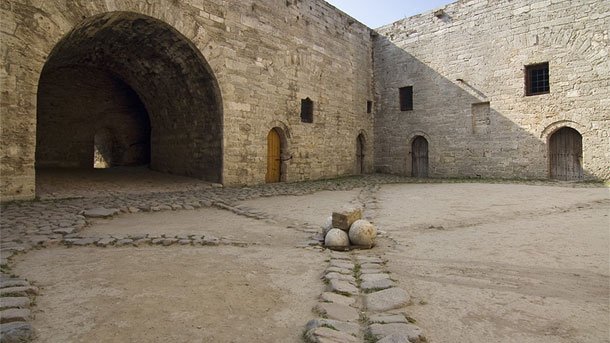The Medieval fortress of Baba Vida is situated on the bank of the Danube River - at a place where the river makes a sharp turn. It lies in the town of Vidin, near the northwestern Bulgarian border.
According to legends the town and the fortress were named after Vida who was the daughter of a wealthy ruler, whose kingdom covered a vast area from the Carpathian Mountains to the Balkan mountain range (Stara Planina). After her father’s death Vida and her two younger sisters Kula and Gamza shared the inherited lands. Kula founded her estates around the town of today’s town of Vidin. Gamza named her fortress Gazimgrad. Currently on the territory of neighboring Serbia archeological remains, dating back to the late Roman period, can be spotted in an archeological complex called Gamzigrad. The two girls Kula and Gamza got married soon after their father’s death. Unfortunately their husbands were very unwise and spent all their fortune. The third sister Vida declined all marriage proposals. She chose to stay single and dedicated her life to her nationals and in defence of the remains of the great kingdom. She built an inaccessible fortress and a castle where she lived to a ripe old age. Vida was a powerful and just ruler. After her death, people named the fortress after her- Baba (Granny) Vida, also known as the Towers of Baba Vida. There are many legends about Granny Vida. The latter is the most popular among all. All tour guides and historians who take tourists around the fortress tell this legend.

© Photo: wikipedia.bg
The construction plan of the complex was not preserved, but it was constructed during the second half of the 10th century at the latest. Afterwards its territory was extended. Two enclosing walls, an inner and outer wall as well as 9 towers, were built. According to most legends, the best preserved part of the fortress belonged to Tsar Ivan Sracimir, who turned it into his main residence and a feudal castle during the Second Bulgarian Kingdom. He was the last Medieval Bulgarian monarch. The dwelling places, with a look towards the central yard, were situated in the inner zone of the Baba Vida’s towers. Archeologists found there church foundations which date back to the 13th-14th century AD. Mrs. Fionera Filipova who is a keeper of the Historical museum of Vidin tells us more details.

© Photo: www.imagesfrombulgaria.com
“Between the 15th and the 19th century, the fortress served as a defensive work, adapted for the firearms used in this period. The most significant reconstruction of the fortress dates back to the late 17th and the early 18th century. Today the complex is situated over 1 hectare of land. It is enclosed by a moat which is around 12 meters wide and 6 meters deep. In the past people used to fill this moat with water from Danube River. A wooden bridge, later replaced by a stone one, lied in front of the entrance of the fortress. Despite the multiple reconstructions, Baba Vida fortress is now one of the best-preserved Medieval Bulgarian monuments. We can not tell for sure when the fortress was visited by tourists for the first time, but it most probably happened in 1956 when it was declared a tourist site under the management of the Bulgarian Ministry of Defense. Until then the fortress was part of the military garrison in Vidin. In 1964 the fortress was declared a cultural monument”, says Fionera Filipova.

© Photo: wikimedia.org
During the Ottoman rule the residential part of the fortress was destroyed. It was replaced by vaulted stone compartments, used as ammunition and food stores. The first archeological researches were made in the period between 1956 and 1962. As a result, several cultural layers were found. The castle was built over the foundations of the ancient Roman fortress Bononia, dating back to the 2nd century. Signs of the Byzantium, the First Bulgarian, Second Bulgarian Kingdom and the Ottoman Period were found there. In the early 1960’s the stage of the open-air theatre, with a capacity for over 400 people, was built there. It hosts traditional musical and theatrical forums. The conference hall, which was build recently, hosts many exhibitions which present the fortress through the eyes of artists, historians and explorers. It was best described by Felix Kanitz in his book entitled Danubian Bulgaria and the Balkans. Plots of Baba Vida’s fortress as well as huge historical information collected by the renowned Austro-Hungarian explorer in 1882 were published in this book. One can see there the valuable pictures drawn by the Bulgarian artist Ivan Hristov and many other artists who reproduced the emblematic Bulgarian fortress. Mrs. Filipova told us about the interesting idea which was recently accomplished. The attendants of the museum situated in the fortress welcomed the young visitors from several kindergartens in Vidin. They told them the story of the place through the fairy heroes who live in the legends of Baba Vida fortress. The interest shown by the kids exceeded their bravest expectations.

© Photo: archive
“There are several other monuments in the town of Vidin with unique historic features”, Mrs Filipova goes on to say. “One of them is the other fortress named Kaleto. We should not omit Osman Pazvantoglu’s mosque. The library in this mosque was declared a cultural monument of national significance. The synagogue in Vidin which was built at the end of the 19th century is the second largest in Bulgaria after the one in Sofia. The Saint Demetrius Cathedral, which is among the biggest ones in the country, is also situated in this town”, concludes Fionera Filipolva.
In the beginning of the 1980’s, the number of people visiting Bava Vida’s fortress reached 120 000 a year. This was followed by a period of a standstill. Over the last 5-6 years their number varies between 30 000 and 40 000 per annum. However, the number of foreign visitors who come to the town has been constantly on the rise.
English version: Kostadin Atanasov
An architectural and cultural monument of national importance, the church of Saint George the Victorious in the town of Kyustendil is located at the foot of the nearby Osogovo Mountain, in Kolusha neighbourhood. The study and restoration of..
We do not need to travel thousands of kilometers to reach holy Christian places and “drink from the miraculous well” of Orthodox faith. Hundreds of churches and monasteries were built on Bulgarian territory with the faith and the hope..
A hard-to-reach fortress rose on a solitary ridge, which was towering above the Asenitsa River. This place built high in the rocks was once sheltering Thracians, Romans, Byzantines, Western Europeans, Bulgarians and Ottomans. One..

+359 2 9336 661
